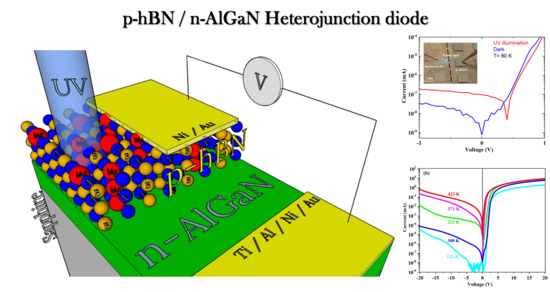Towards P-Type Conduction in Hexagonal Boron Nitride: Doping Study and Electrical Measurements Analysis of hBN/AlGaN Heterojunctions
Abstract
1. Introduction
2. Materials and Methods
3. Results and Discussions
3.1. Morphology and Structural Characterizations of Undoped and Mg Doped h-BN Layers
3.2. SIMS Measurement of Mg Doping Concentration
3.3. Ohmic Contact in h-BN Layers
3.4. Mg Doped h-BN/n-AlGaN Heterostructures
4. Conclusions
Supplementary Materials
Author Contributions
Funding
Data Availability Statement
Conflicts of Interest
References
- Li, J.; Oder, T.N.; Nakarmi, M.L.; Lin, J.Y.; Jiang, H.X. Optical and electrical properties of Mg-doped p-type AlxGa 1-xN. Appl. Phys. Lett. 2002, 80, 1210–1212. [Google Scholar] [CrossRef]
- Nakarmi, M.L.; Kim, K.H.; Khizar, M.; Fan, Z.Y.; Lin, J.Y.; Jiang, H.X. Electrical and optical properties of Mg-dopedAl 0.7Ga 0.3N alloys. Appl. Phys. Lett. 2005, 86, 1–3. [Google Scholar] [CrossRef]
- Nakarmi, M.L.; Nepal, N.; Ugolini, C.; Altahtamouni, T.M.; Lin, J.Y.; Jiang, H.X. Correlation between optical and electrical properties of Mg-doped AlN epilayers. Appl. Phys. Lett. 2006, 89, 152120–152123. [Google Scholar] [CrossRef]
- Taniyasu, Y.; Kasu, M.; Makimoto, T. An aluminium nitride light-emitting diode with a wavelength of 210 nanometres. Nature 2006, 441, 325–328. [Google Scholar] [CrossRef]
- Pernot, C.; Kim, M.; Fukahori, S.; Inazu, T.; Fujita, T.; Nagasawa, Y.; Hirano AIppommatsu, M.; Iwaya, M.; Kamiyama, S.; Akasaki, I.; et al. Improved efficiency of 255–280 nm AlGaN-based light-emitting diodes. Appl. Phys. Express 2010, 3, 061003–061004. [Google Scholar] [CrossRef]
- Watanabe, K.; Taniguchi, T.; Niiyama, T.; Miya, K.; Taniguchi, M. Far-ultraviolet plane-emission handheld device based on hexagonal boron nitride. Nat. Photonics 2009, 3, 591–594. [Google Scholar] [CrossRef]
- Dahal, R.; Li, J.; Majety, S.; Pantha, B.N.; Cao, X.K.; Lin, J.Y.; Jiang, H.X. Epitaxially grown semiconducting hexagonal boron nitride as a deep ultraviolet photonic material. Appl. Phys. Lett. 2011, 98, 88–91. [Google Scholar] [CrossRef]
- Majety, S.; Li, J.; Cao, X.K.; Dahal, R.; Pantha, B.N.; Lin, J.Y.; Jiang, H.X. Epitaxial growth and demonstration of hexagonal BN/AlGaN p-n junctions for deep ultraviolet photonics. Appl. Phys. Lett. 2012, 100. [Google Scholar] [CrossRef]
- Huang, B.; Cao, X.K.; Jiang, H.X.; Lin, J.Y.; Wei, S.H. Origin of the significantly enhanced optical transitions in layered boron nitride. Phys. Rev. B Condens. Matter Mater. Phys. 2012, 86, 1–5. [Google Scholar] [CrossRef]
- Jiang, H.X.; Lin, J.Y. Review—Hexagonal Boron Nitride Epilayers: Growth, Optical Properties and Device Applications ECS. J. Solid State Sci. Technol. 2017, 6, Q3012–Q3021. [Google Scholar] [CrossRef]
- Maity, A.; Grenadier, S.J.; Li, J.; Lin, J.Y.; Jiang, H.X. High sensitivity hexagonal boron nitride lateral neutron detectors. Appl. Phys. Lett. 2019, 114, 222102–222104. [Google Scholar] [CrossRef]
- Li, X.; Jordan, M.B.; Ayari, T.; Sundaram, S.; El Gmili, Y.; Alam, S.; Alam, M.; Patriarche, G.; Voss, P.L.; Salvestrini, J.P.; et al. Flexible metal-semiconductor-metal device prototype on wafer-scale thick boron nitride layers grown by MOVPE. Sci. Rep. 2017, 7, 1–8. [Google Scholar] [CrossRef] [PubMed]
- Nose, K.; Oba, H.; Yoshida, T. Electric conductivity of boron nitride thin films enhanced by in situ doping of zinc. Appl. Phys. Lett. 2006, 89, 3–6. [Google Scholar] [CrossRef]
- Attaccalite, C.; Bockstedte, M.; Marini, A.; Rubio, A.; Wirtz, L. Coupling of excitons and defect states in boron-nitride nanostructures. Phys. Rev. B Condens. Matter Mater. Phys. 2011, 83, 1–8. [Google Scholar] [CrossRef]
- Laleyan, D.A.; Zhao, S.; Woo, S.Y.; Tran, H.N.; Le, H.B.; Szkopek, T.; Guo, H.; Botton, G.A.; Mi, Z. AlN/h-BN Heterostructures for Mg Dopant-Free Deep Ultraviolet Photonics. Nano Lett. 2017, 17, 3738–3743. [Google Scholar] [CrossRef]
- Watanabe, M.O.; Itoh, S.; Mizushima, K.; Sasaki, T. Electrical properties of BC2N thin films prepared by chemical vapor deposition. J. Appl. Phys. 1995, 78, 2880–2882. [Google Scholar] [CrossRef]
- Uddin, M.R.; Li, J.; Lin, J.Y.; Jiang, H.X. Probing carbon impurities in hexagonal boron nitride epilayers. Appl. Phys. Lett. 2017, 110, 182107. [Google Scholar] [CrossRef]
- Lu, M.; Bousetta, A.; Bensaoula AWaters, K.; Schultz, J.A. Electrical properties of boron nitride thin films grown by neutralized nitrogen ion assisted vapor deposition. Appl. Phys. Lett. 1995, 5, 622–624. [Google Scholar] [CrossRef]
- He, B.; Zhang, W.J.; Yao, Z.Q.; Chong, Y.M.; Yang, Y.; Ye, Q.; Pan, X.J.; Zapien, J.A.; Bello, I.; Lee, S.T.; et al. P -type conduction in beryllium-implanted hexagonal boron nitride films. Appl. Phys. Lett. 2009, 95, 252106. [Google Scholar] [CrossRef]
- Sun, F.; Hao, Z.; Liu, G.; Wu, C.; Lu, S.; Huang, S.; Liu, C.; Hong, Q.; Chen, X.; Cai, D.; et al. P-Type conductivity of hexagonal boron nitride as a dielectrically tunable monolayer: Modulation doping with magnesium. Nanoscale 2018, 10, 4361–4369. [Google Scholar] [CrossRef] [PubMed]
- Weston, L.; Wickramaratne, D.; Van De Walle, C.G. Hole polarons and p -type doping in boron nitride polymorphs. Phys. Rev. B 2017, 96, 1–4. [Google Scholar] [CrossRef]
- Li, X.; Sundaram, S.; El Gmili, Y.; Ayari, T.; Puybaret, R.; Patriarche, G.; Voss, P.L.; Salvestrini, J.P.; Ougazzaden, A. Large-area two-dimensional layered hexagonal boron nitride grown on sapphire by metalorganic vapor phase epitaxy. Cryst. Growth Des. 2016, 16, 3409–3415. [Google Scholar] [CrossRef]
- Ayari, T.; Sundaram, S.; Li, X.; El Gmili, Y.; Voss, P.L.; Salvestrini, J.P.; Ougazzaden, A. Wafer-scale controlled exfoliation of metal organic vapor phase epitaxy grown InGaN/GaN multi quantum well structures using low-tack two-dimensional layered h-BN. Appl. Phys. Lett. 2016, 108, 171105–171106. [Google Scholar] [CrossRef]
- Snure, M.; Paduano, Q.; Kiefer, A. Effect of surface nitridation on the epitaxial growth of few-layer sp2BN. J. Cryst. Growth 2016, 436, 16–22. [Google Scholar] [CrossRef]
- Paduano, Q.; Snure, M.; Weyburne, D.; Kiefer, A.; Siegel, G.; Hu, J. Metalorganic chemical vapor deposition of few-layer sp2bonded boron nitride films. J. Cryst. Growth 2016, 449, 148–155. [Google Scholar] [CrossRef]
- Yang, X.; Nitta, S.; Nagamatsu, K.; Bae, S.Y.; Lee, H.J.; Liu, Y.; Pristovsek, M.; Honda, Y.; Amano, H. Growth of hexagonal boron nitride on sapphire substrate by pulsed-mode metalorganic vapor phase epitaxy. J. Cryst. Growth 2018, 482, 1–8. [Google Scholar] [CrossRef]
- Chugh, D.; Wong-Leung, J.; Li, L.; Lysevych, M.; Tan, H.H.; Jagadish, C. Flow modulation epitaxy of hexagonal boron nitride 2D. Materials 2018, 5, 045018–045022. [Google Scholar]
- Bayram, C.; Pau, J.L.; McClintock, R.; Razeghi, M. Delta-doping optimization for high quality p -type GaN. J. Appl. Phys. 2008, 104, 1–6. [Google Scholar] [CrossRef]
- Lachab, M.; Youn, D.H.; Qhalid Fareed, R.S.; Wang, T.; Sakai, S. Characterization of Mg-doped GaN grown by metalorganic chemical vapor deposition. Solid. State. Electron. 2000, 44, 1669–1677. [Google Scholar] [CrossRef]
- Hsu, C.C.; Yuan, J.S.; Cohen, R.M.; Stringfellow, G.B. Doping studies for InP grown by organometallic vapor phase epitaxy. J. Cryst. Growth 1986, 74, 535–542. [Google Scholar] [CrossRef]
- Henck, H.; Pierucci, D.; Ben Aziza, Z.; Silly, M.G.; Gil, B.; Sirotti, F.; Cassabois, G.; Ouerghi, A. Stacking fault and defects in single domain multilayered hexagonal boron nitride. Appl. Phys. Lett. 2017, 110, 023101–023105. [Google Scholar] [CrossRef]
- Maity, A.; Grenadier, S.J.; Li, J.; Lin, J.Y.; Jiang, H.X. Hexagonal boron nitride neutron detectors with high detection efficiencies. J. Appl. Phys. 2018, 123, 1–8. [Google Scholar] [CrossRef]
- Steinborn, C.; Herrmann, M.; Keitel, U.; Schönecker, A.; Räthel, J.; Rafaja, D.; Eichler, J. Correlation between microstructure and electrical resistivity of hexagonal boron nitride ceramics. J. Eur. Ceram. Soc. 2013, 33, 1225–1235. [Google Scholar] [CrossRef]
- Narushima, S.; Mizoguchi, H.; Shimizu, K.I.; Ueda, K.; Ohta, H.; Hirano, M.; Kamiya, T.; Hosono, H. A p-type amorphous oxide semiconductor and room temperature fabrication of amorphous oxide p-n heterojunction diodes. Adv. Mater. 2003, 15, 1409–1413. [Google Scholar] [CrossRef]
- Hao, G.D.; Tsuzuki, S.; Inoue, S. Small valence band offset of h-BN/Al 0.7 Ga 0.3 N heterojunction measured by X-ray photoelectron spectroscopy. Appl. Phys. Lett. 2019, 114, 1–6. [Google Scholar] [CrossRef]

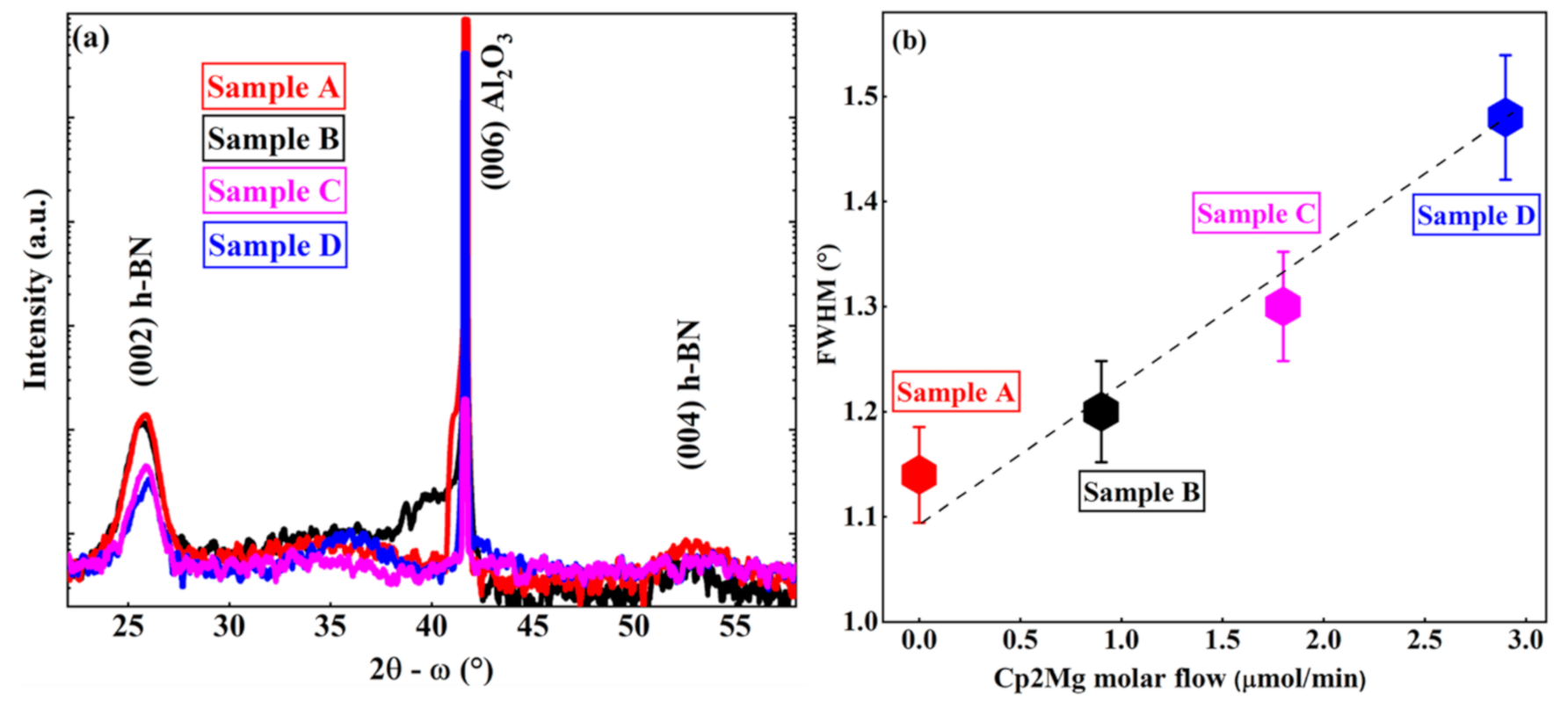
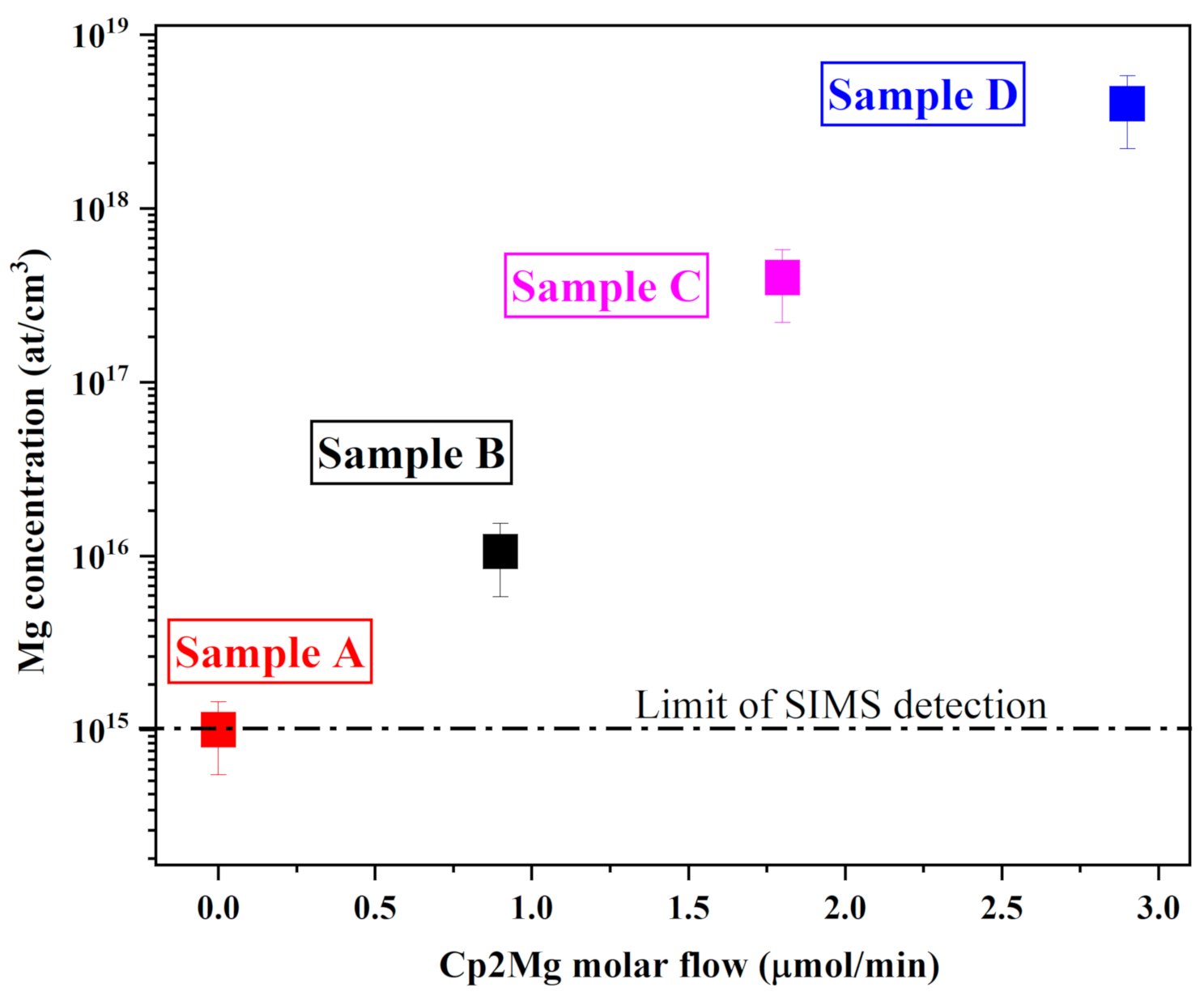

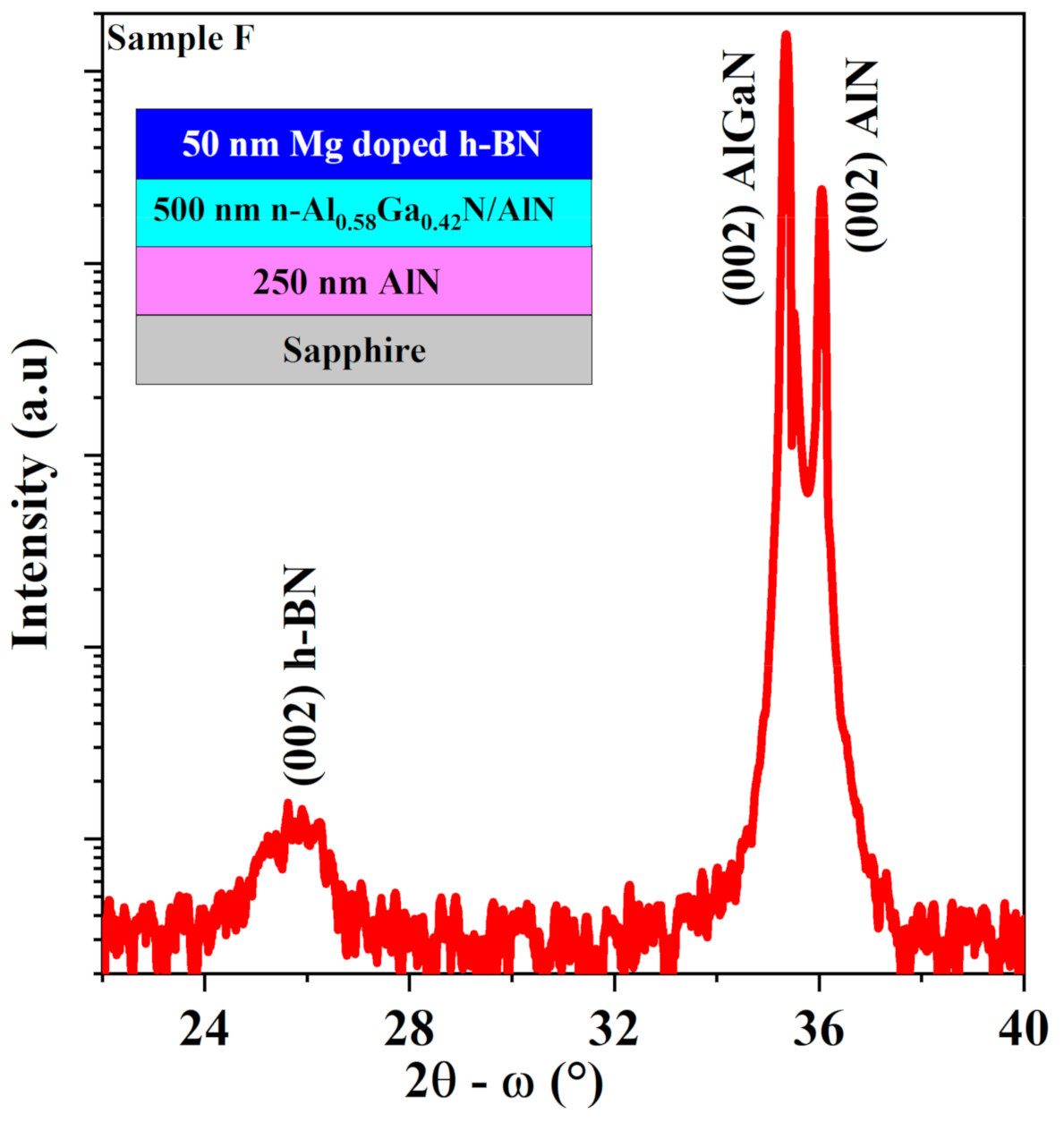

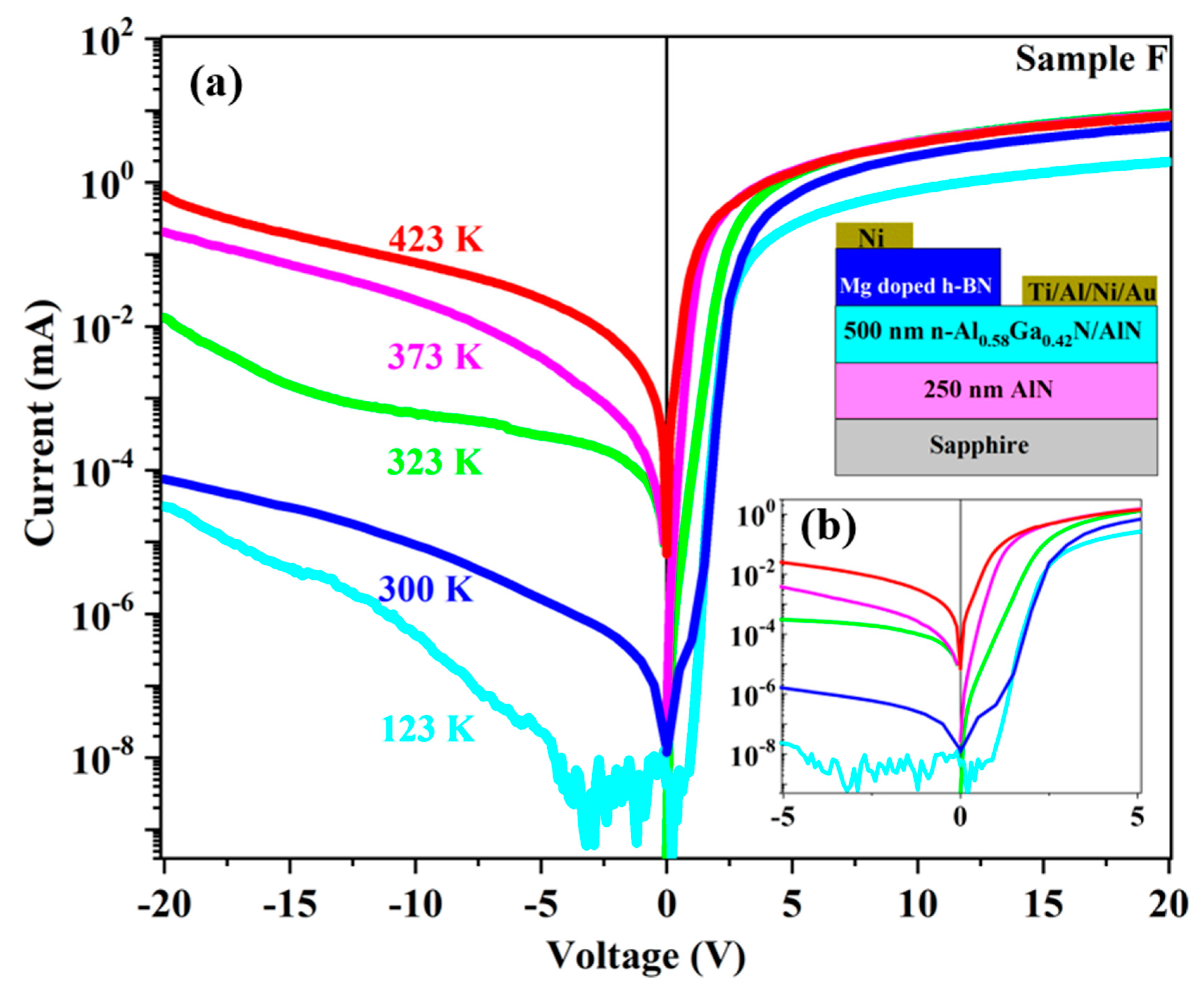
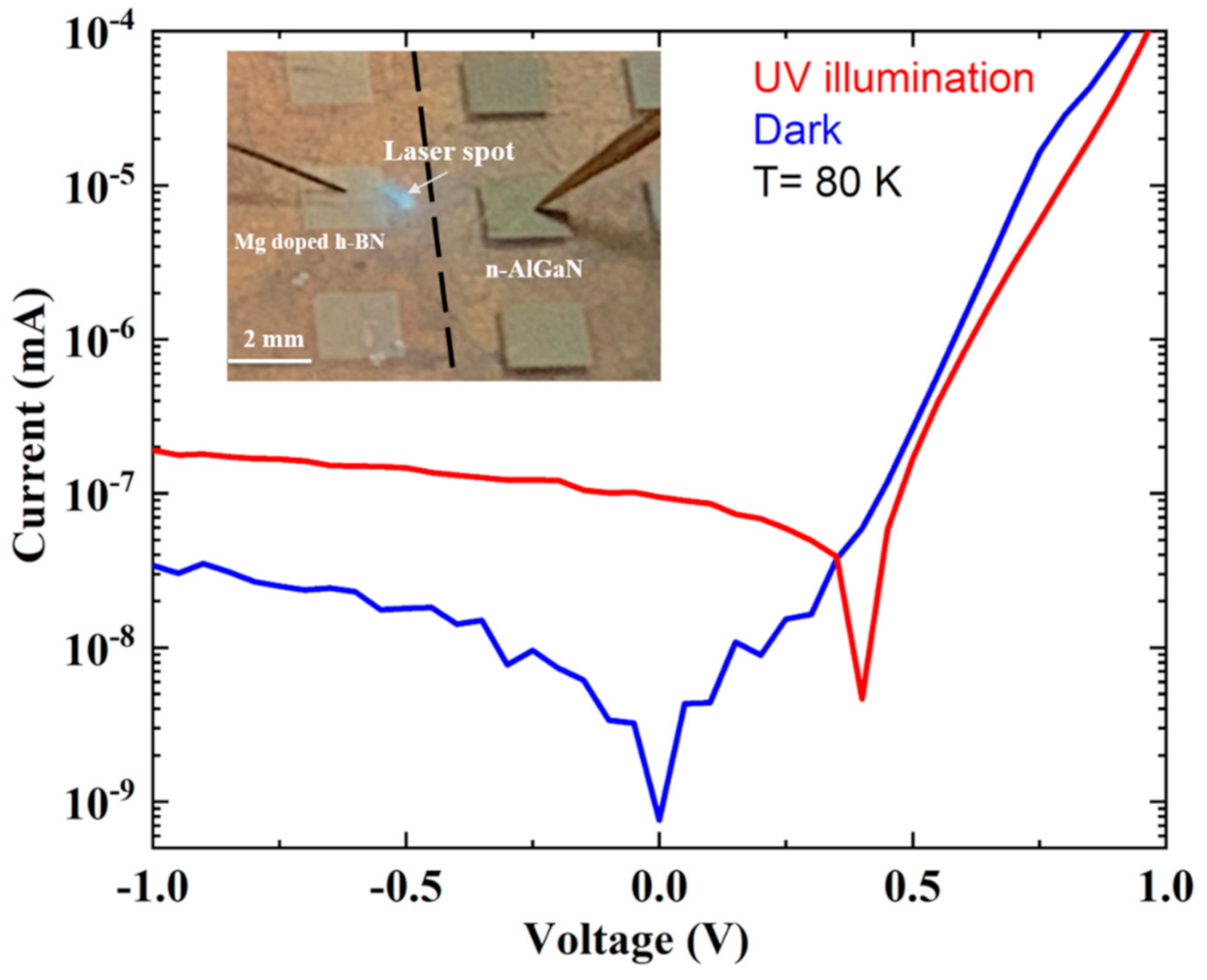

Publisher’s Note: MDPI stays neutral with regard to jurisdictional claims in published maps and institutional affiliations. |
© 2021 by the authors. Licensee MDPI, Basel, Switzerland. This article is an open access article distributed under the terms and conditions of the Creative Commons Attribution (CC BY) license (http://creativecommons.org/licenses/by/4.0/).
Share and Cite
Mballo, A.; Srivastava, A.; Sundaram, S.; Vuong, P.; Karrakchou, S.; Halfaya, Y.; Gautier, S.; Voss, P.L.; Ahaitouf, A.; Salvestrini, J.P.; et al. Towards P-Type Conduction in Hexagonal Boron Nitride: Doping Study and Electrical Measurements Analysis of hBN/AlGaN Heterojunctions. Nanomaterials 2021, 11, 211. https://doi.org/10.3390/nano11010211
Mballo A, Srivastava A, Sundaram S, Vuong P, Karrakchou S, Halfaya Y, Gautier S, Voss PL, Ahaitouf A, Salvestrini JP, et al. Towards P-Type Conduction in Hexagonal Boron Nitride: Doping Study and Electrical Measurements Analysis of hBN/AlGaN Heterojunctions. Nanomaterials. 2021; 11(1):211. https://doi.org/10.3390/nano11010211
Chicago/Turabian StyleMballo, Adama, Ashutosh Srivastava, Suresh Sundaram, Phuong Vuong, Soufiane Karrakchou, Yacine Halfaya, Simon Gautier, Paul L. Voss, Ali Ahaitouf, Jean Paul Salvestrini, and et al. 2021. "Towards P-Type Conduction in Hexagonal Boron Nitride: Doping Study and Electrical Measurements Analysis of hBN/AlGaN Heterojunctions" Nanomaterials 11, no. 1: 211. https://doi.org/10.3390/nano11010211
APA StyleMballo, A., Srivastava, A., Sundaram, S., Vuong, P., Karrakchou, S., Halfaya, Y., Gautier, S., Voss, P. L., Ahaitouf, A., Salvestrini, J. P., & Ougazzaden, A. (2021). Towards P-Type Conduction in Hexagonal Boron Nitride: Doping Study and Electrical Measurements Analysis of hBN/AlGaN Heterojunctions. Nanomaterials, 11(1), 211. https://doi.org/10.3390/nano11010211




